Cube, Cuboid, Prism and Cylinder
1. State the basic formulas for calculating volume and surface area:
- cube
- cuboid (rectangular prism)
- prism
- cylinder
Solution:
Cube
a – edge of the cube
volume V = a
3
surface area S = 6a
2
 Cuboid
Cuboid
a, b, c – edges of the cuboid
volume V = a·b·c
surface area S = 2(ab+ac+bc)
 Prism
Prism
S
p – area of the base
Q – lateral area
v – height of the prism
volume V = S
p·v
surface area S = 2S
p + Q
Cylinder
r – radius of the base
v – height of the cylinder
volume V = π·r
2·v
surface area S = 2πr(r+v)
Q = 2πrv
2. Two cube-shaped crates with edges a = 70 cm, b = 90 cm are to be replaced by one cube-shaped crate.
What will be its edge length?
Solution:

The edge of the replacement cube will be c = 102.3 cm.
3. The edge of the second cube is 2 cm larger than the edge of the first cube. The difference of the cubes’ volumes is 728 cm3.
Calculate the edge lengths of both cubes.
Solution:
Edge of the first cube: x
Edge of the second cube: x + 2
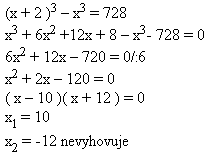
The edge of the first cube is 10 cm, of the second 12 cm.
4. A cube with edge a is given. Known values are in the table.
Complete the table!
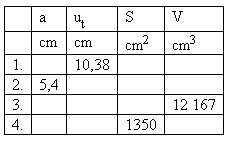
Solution:

5. The edges of two cubes differ by 22 cm. Their surface areas differ by 19,272 cm2.
Determine the edges of both cubes.
Solution:
x – edge of the first cube
y – edge of the second cube
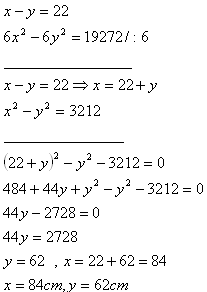
The edges of the cubes are x = 84 cm and y = 62 cm.
6. A cuboid has dimensions a = 4 cm, b = 3 cm, c = 5 cm.
Calculate the angle α between the base diagonal and the space diagonal.
Solution:
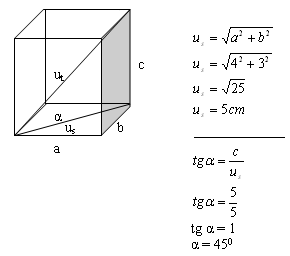
The angle between the diagonals is α = 45°.
7. The surface area of a cuboid is S = 376 cm2. Its edges are in the ratio a:b:c = 3:4:5.
Calculate the volume of this cuboid.
Solution:
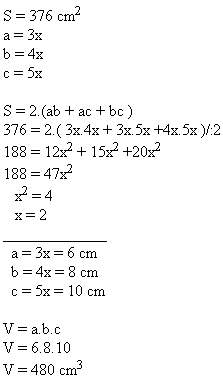
The volume of the cuboid is V = 480 cm
3.
8. A water tank in the shape of a cuboid contains 1500 hl of water; the water height is 2.5 m.
Determine the base dimensions if one dimension is 4 m greater than the other.
Solution:
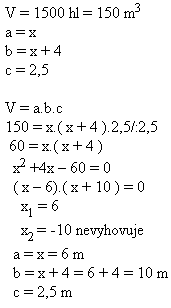
The base dimensions of the tank are a = 6 m, b = 10 m.
9. Calculate the volume of a cuboid if its base has S1 = 272 cm2 and the lateral faces have S2 = 240 cm2, S3 = 255 cm2.
Solution:
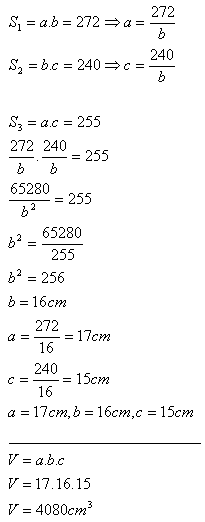
The volume of the cuboid is 4080 cm
3.
10. What is the mass of an iron rod (ρ = 7800 kg·m-3) that is 1.5 meters long and has a square cross-section with side a = 45 mm?
Solution:
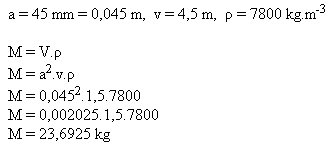
The mass of the iron rod is about M = 23.7 kg.
11. The base of a right triangular prism is a right triangle with legs a = 9 cm, b = 12 cm. The height of the prism is twice the hypotenuse of the right-angled base.
Calculate the volume and surface area of the prism.
Solution:
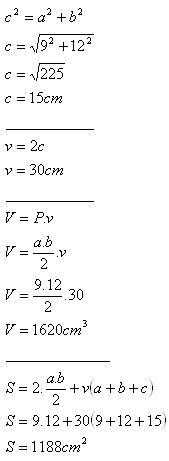
The triangular prism has volume V = 1620 cm
3 and surface area S = 1188 cm
2.
12. How much soil must be moved when digging a straight trench 170 m long, whose cross-section is an isosceles trapezoid with bases a = 150 cm, c = 80 cm and height v = 83 cm?
Solution:
l = 170 m = 17000 cm

About 162.3 m
3 of soil must be moved.
13. Calculate the volume and surface area of a prism whose base is a rhombus with diagonals u1 = 12 cm, u2 = 16 cm. The height of the prism equals twice the base edge.
Solution:

The volume of the prism is V = 1920 cm
3, and its surface area is S = 992 cm
2.
14. The table lists quantities characterizing various cylinders.
Complete the table!
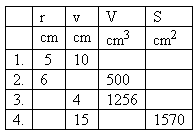
Solution:
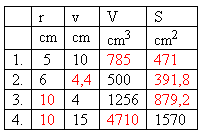
15. The lateral surface of a right circular cylinder, developed into a plane, is a square with area a2 = 81 cm2.
Determine the base radius r, the height of the cylinder v, and its volume V.
Solution:

The cylinder has base radius r = 1.433 cm, height v = 9 cm, and volume V = 58.03 cm
3.
16. An equilateral cylinder (v = 2r) has volume V = 250 cm3.
Calculate the surface area of this solid.
Solution:

The surface area of this cylinder is S = 219 cm
2.
17. An aluminum wire (ρ = 2.7 g·cm-3) with diameter d = 3 mm has total mass m = 1.909 kg.
Determine the length of the wire l.
Solution:

The length of the aluminum wire is approximately 100 m.
18. The outer circumference of a brass tube (ρ = 8.5 g·cm-3) is 31.4 cm. Its mass is 3.14 kg and its length is 60 cm.
What is the wall thickness of the tube?
Solution:
O = 31.4 cm
v = 60 cm
m = 3140 kg
ρ = 8.5 kg·cm
-3
wall thickness = x
In this problem it is the volume of a hollow cylinder with an annulus as its base.

The wall thickness of the tube is x = 0.2 cm.